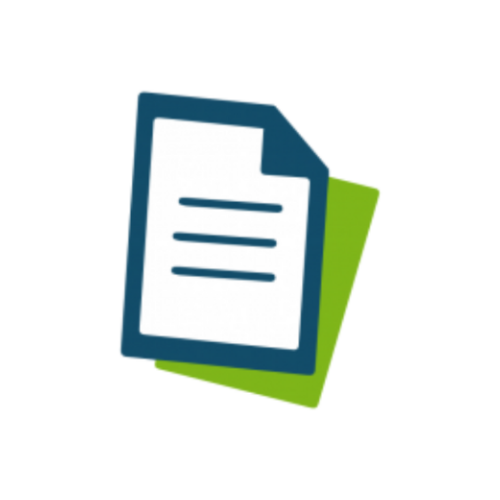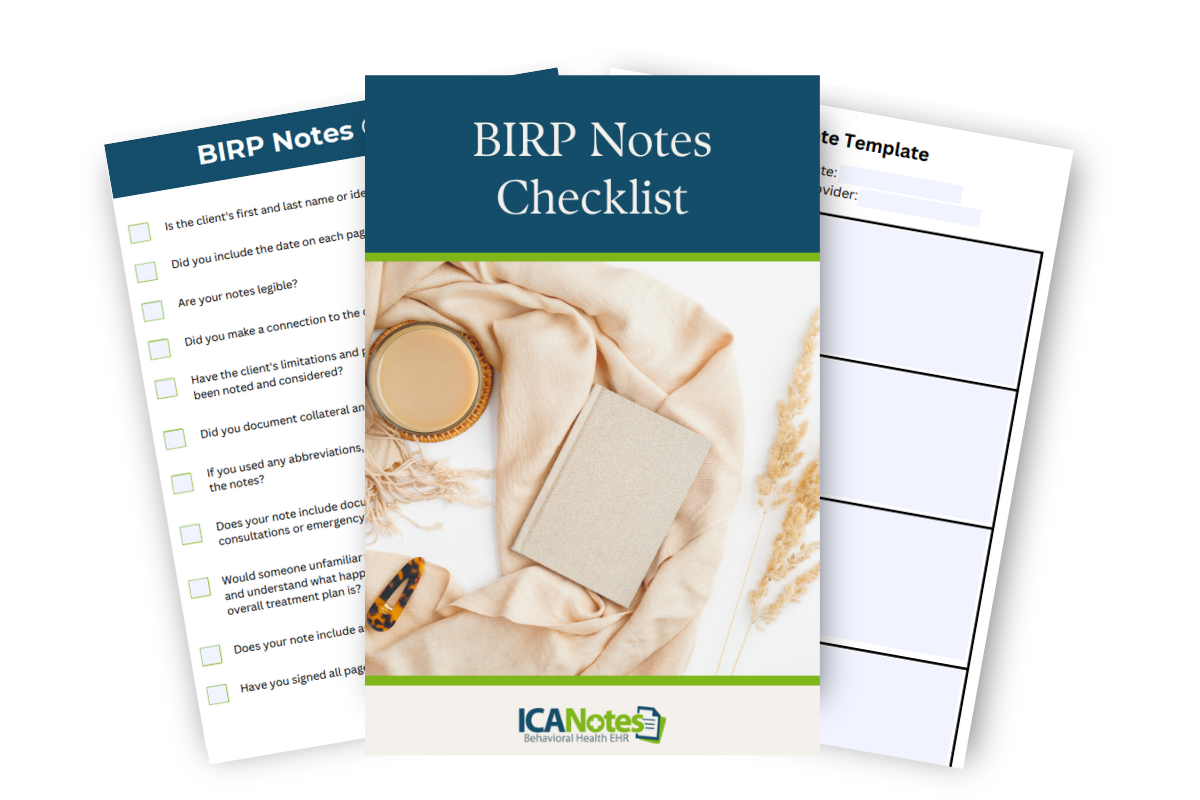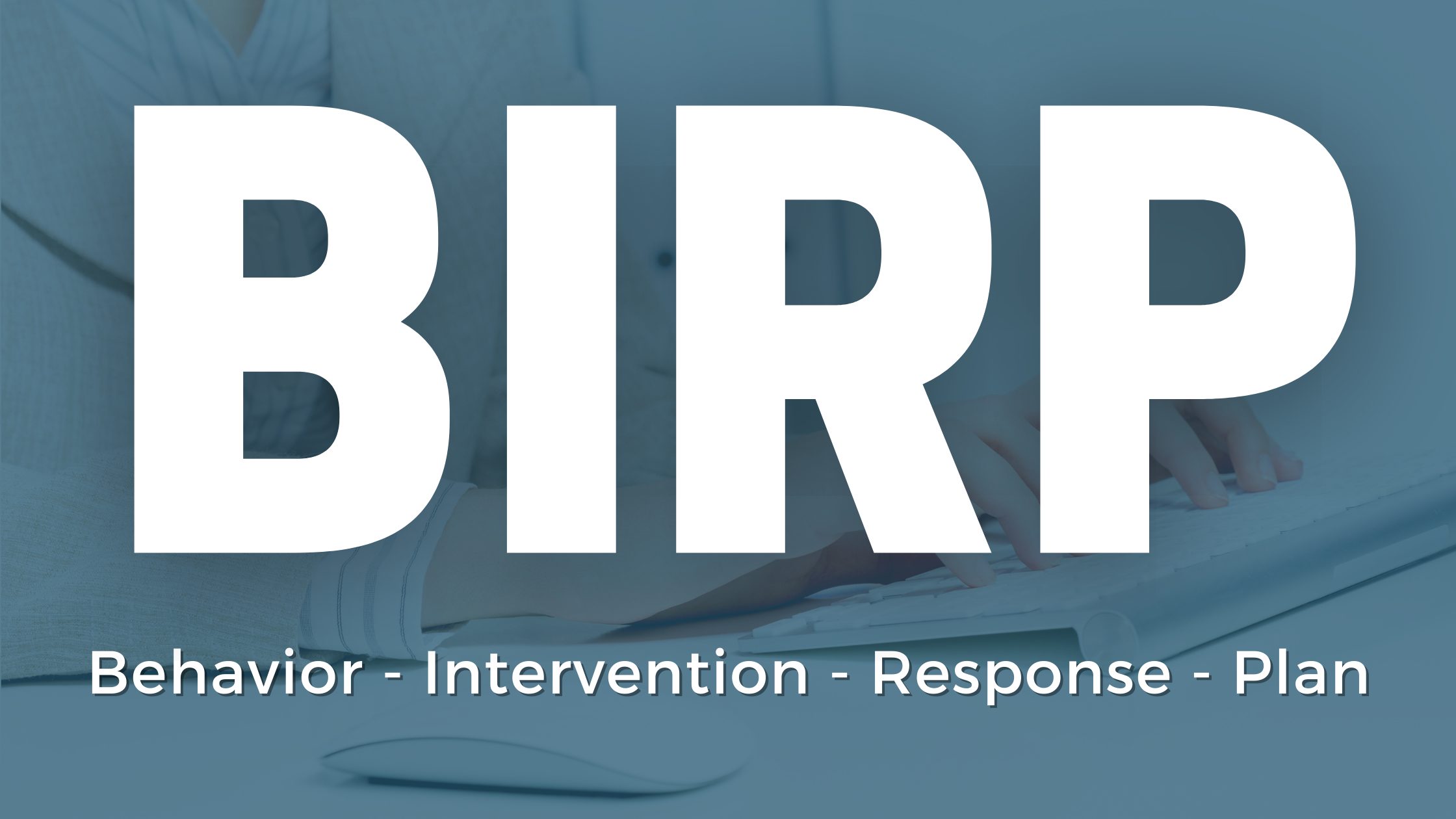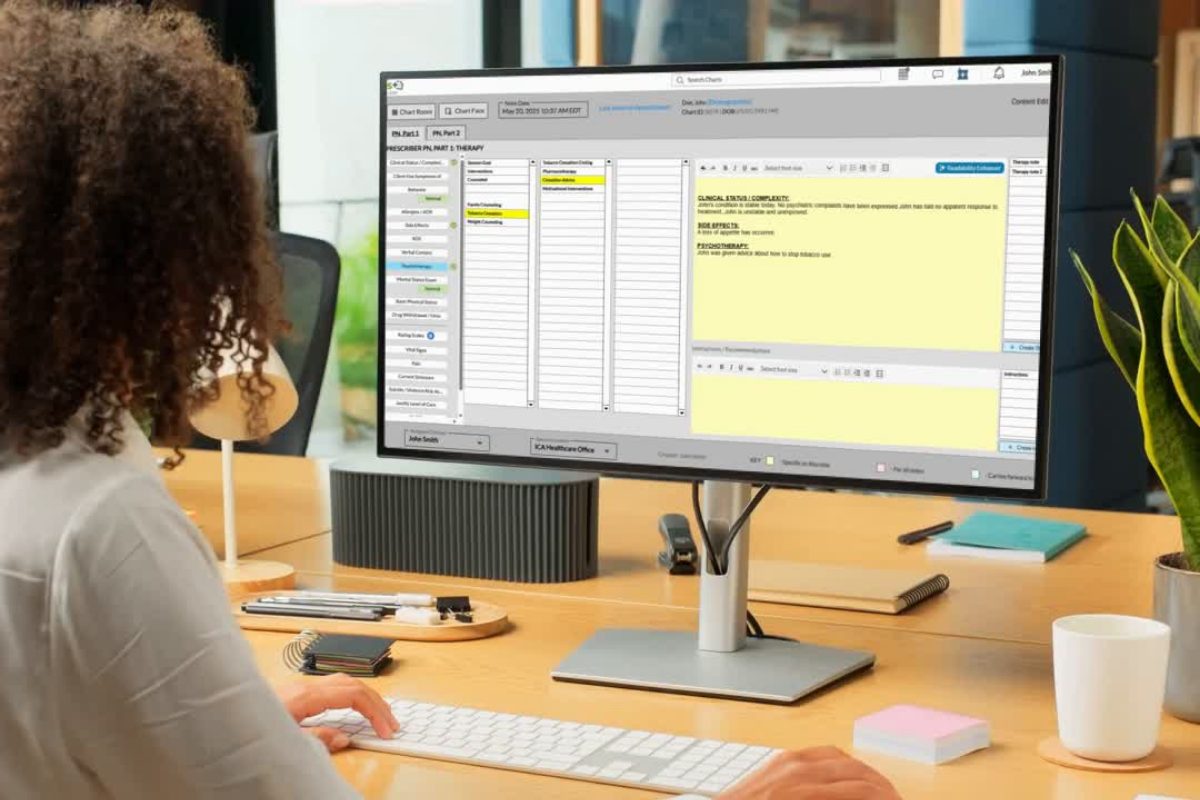Blog > Documentation > BIRP Notes Guide for Mental Health Professionals
BIRP Notes Guide for Mental Health Professionals
If you're searching for a comprehensive BIRP Notes Guide to improve your clinical documentation, you're in the right place. As a mental health professional, you know that writing thorough, focused notes is essential — but also time-consuming when you’re balancing client sessions, treatment planning, and administrative duties. Fortunately, the BIRP note format offers a streamlined way to capture client behavior, interventions, responses, and treatment plans in a consistent, structured manner. In this guide, you'll learn how to write effective BIRP notes, explore real-world examples, and download a free BIRP Notes template and checklist to support your workflow.

Last Updated: September 11, 2025


What You'll Learn
-
How to structure BIRP notes that are clinically accurate, legally compliant, and audit-ready.
-
Common mistakes clinicians make in BIRP documentation — and how to avoid them.
-
Time-saving strategies for documenting individual and group therapy sessions.
-
Ways to streamline BIRP notes with EHR systems like ICANotes, including automation tools.
Whether you're a psychiatrist, therapist, counselor, or social worker, mastering BIRP notes can help you save time, enhance communication with other providers, and ensure compliance. As a clinician you understand how much work goes into writing good notes and how challenging it is to consistently write comprehensive notes in addition to seeing clients.
The BIRP note format can make this process much more efficient for busy mental health professionals. Find out what BIRP notes are and how to write them so you can start creating your mental health notes more efficiently. Review our sample BIRP notes and download our BIRP Notes template and reference guide.
What is a BIRP Note?
BIRP notes are a format mental health professionals use to document their clients' progress and treatment plans. BIRP is an acronym used to help clinicians organize their notes into four specific sections — Behavior, Intervention, Response, and Plan.
This consistent method of writing notes is widely accepted for its standard format. This consistency makes the BIRP notes template an important resource for communicating client information with other healthcare providers.
Why Are BIRP Notes Important?
BIRP notes are a type of clinical record that helps ensure clients receive continuous care, especially if they change providers or see multiple specialists.
Timely updates to records provide everyone involved with the most accurate information to make their care decisions. This updated information makes reviewing notes more convenient for providers, as well as ensures the safety of the client.
Imagine a psychiatrist prescribes their client medication and forgets to make a note of the prescription in the BIRP note. If the client sees another specialist, the new provider will have no knowledge of the medication.
This miscommunication can lead to providers over-medicating clients or prescribing medications that can potentially react with each other and cause negative side effects for the client.
Proper documentation is also critical in case you get audited or your notes need to be used in a court proceeding. Documentation of appointments with clients is required in most states, and BIRP notes are an effective way to help you comply with requirements.
BIRP Notes Template
Make your clinical documentation faster, clearer, and more compliant. Download our free BIRP Notes Checklist and template—designed specifically for behavioral health professionals. This handy PDF guide will help ensure every note you write is complete, organized, and audit-ready. Perfect for use during or after sessions!

How Are BIRP Notes Used?
Most forms of progress notes are used to streamline the note-writing process, and BIRP notes are no different. Standardized forms of documenting clinical records like BIRP, DAP, or SOAP makes note writing fast so providers can spend more time with clients.
BIRP notes also make reading notes simple so providers can communicate a client's progress and plan with other clinicians. While one of the most important uses for BIRP notes is to track a client's progress, they can also be used for insurance reimbursement, billing and planning.

Writing BIRP Notes
BIRP notes consist of four main elements — Behavior, Intervention, Response, and Plan. The standard format for BIRP notes allows mental health professionals to write high-quality notes at an efficient rate.
This way of organizing clinical data helps ensure client care is consistent and all important information is documented properly. To better understand what to include in each category, let's dive into the individual elements of BIRP notes.
Behavior
The behavior section of a BIRP note is where you record the problem being presented, how the client appears and behaves and your impressions of the client during the appointment. Record both subjective and objective observations in this section:
- Subjective observations are anything the client reports feeling, their thoughts and opinions, as well as symptoms they may experience. Subjective notes are often recorded as direct quotes from the client.
- Objective observations come from the provider's point of view. Note the client's appearance, how they acted and what kinds of signs they presented.
Does the client seem frustrated or unwilling to participate? Did they do their homework or make an effort toward progress? Make a note of actions like hesitation to respond to prompts or enthusiasm toward activities. While it can be tempting to record everything the client says, limit yourself to relevant observations so your notes are concise and focused.
Intervention
The first section of a BIRP note is dedicated to the client and the intervention section shifts to a strong focus on the counselor's methods for intervention.
This section of your note is where you should outline and record the methods you use to help the client reach their objectives and goals of treatment. The intervention section should be a detailed account of what you did as the mental health professional during the session.
Include documentation of questions you asked and your reasoning for asking them, intervention techniques you used, and your decisions to adjust the treatment plan if necessary. Use verbs to show what you actively did to work with the client. Consider using these 10 verbs in your BIRP notes:
- Encouraged
- Validated
- Role-played
- Reviewed
- Supported
- Reinforced
- Modeled
- Prompted
- Recommended
- Taught
Noting which general category of intervention techniques the methods you applied in an appointment fall under can also be helpful. For example, you may list cognitive behavioral therapy, art therapy, or other relevant methods.
Response
Next, you'll want to record your client's response to the interventions you chose during the specific session and to the therapy as a whole. Document what they said and the way they reacted.
How do they feel about the techniques used? Here, you can note their responses to your questions and questions they may have asked regarding the intervention.
Try to be as detailed as possible in the response section of your BIRP notes.
Be specific about what bothered or excited the client and what their immediate reactions were. You can use direct quotes here to ensure the description is accurate.
If the client changes their mind about a therapy, document the change in your notes.
Plan
In the final section of BIRP notes, plan for your next session with the client. Provide the date and time the appointment is scheduled for as well as what you will focus on. The plan section allows you to base your future appointments on the progress you make during each session.
Your plan for the next session and the treatment plan as a whole will depend on:
- What you uncover during sessions
- The level of determination the client demonstrates
- Whether or not their goals have changed
Document what will happen next for both you and the client. Did you assign any homework for your client to complete before the next session? Plan to review it next time. What techniques will you use in the next appointment?
If you make any changes to the overall treatment plan, make a note of the changes and the reasoning for the decision.
Sample BIRP Notes
When written correctly, BIRP notes are an effective tool to use in the behavioral health field. Of course, good note writing comes with practice. Referencing relevant BIRP notes samples can also be helpful. Let's take a look at a few sample BIRP notes on depression and other mental health cases.
Counseling BIRP Note Example
Imagine you're treating a client diagnosed with depression. Your notes for a regularly scheduled individual therapy appointment might look like the following example. This note provides a clear account of the techniques the provider offered to the client and how they plan to use them between sessions. There is also a clear focus set in place for the next appointment.

Sample Individual Therapy BIRP Note (Depression & Sleep Difficulties)
Date/Time: September 11, 2025, 2:00–3:00 pm
Client: Adult, 32 years old
Presenting Problem: Major depressive symptoms with insomnia
-
Behavior:
The client reported persistent negative thoughts and ongoing sleep disturbance since the last session, averaging 4–5 hours of sleep per night. Client described feeling “exhausted and hopeless” and endorsed increased difficulty concentrating at work. In session, client appeared fatigued, with slowed speech, downcast affect, and limited eye contact. Mood was described as “depressed.” Client verbalized, “I’m desperate for some relief.” No suicidal ideation was reported, though client acknowledged feeling overwhelmed at times. -
Intervention:
Therapist introduced and practiced progressive muscle relaxation combined with diaphragmatic breathing as a bedtime routine. Explored cognitive distortions contributing to negative self-talk. Therapist guided the client in reframing the thought “I can’t do anything right” into more balanced alternatives such as “It’s okay to make mistakes” and “I am capable and have succeeded in many areas.” Therapist provided psychoeducation on sleep hygiene, including consistent bedtime, limiting screen use before sleep, and creating a calming pre-sleep environment. Encouraged the client to pair relaxation techniques with journaling to track mood and thought patterns before bed. -
Response:
The client engaged actively in relaxation and breathing exercises and was able to visualize peaceful imagery (e.g., beach setting). Reported feeling “a little calmer” after the exercise. Client initially struggled to identify examples of negative thoughts but, with support, generated several and was able to replace them with more constructive phrases. Client expressed willingness to attempt the relaxation routine at home and verbalized understanding of the sleep hygiene recommendations. Affect remained flat but slightly more hopeful at session’s end. -
Plan:
Client will practice relaxation and breathing exercises nightly before bed and maintain a sleep log documenting hours slept and perceived restfulness. Client will track negative thoughts during the week, noting attempts to reframe them. At the next session, therapist and client will review sleep patterns and cognitive restructuring progress, with a focus on building a personalized list of positive self-statements. Longer-term goals include reducing depressive symptoms, improving sleep quality to 7+ hours per night, and strengthening coping skills for negative thought patterns.
Psychiatry BIRP Note Example
Two months ago, you diagnosed a young patient at a psychiatric treatment center with bipolar disorder. At that appointment, you prescribed her medication to help with her mood swings. Today, the patient has returned for a follow-up appointment. This BIRP note might look like the following example. In this case, the patient must give the medication more time to see results. In the meantime, you'd want to help the patient find a support system so she feels less isolated and to help her come to terms with her condition.

Sample Psychiatrist BIRP Note (Medication Management – Bipolar Disorder with Mood Stabilizer)
Sample Psychiatrist BIRP Note (Medication Management – Bipolar Disorder With Mood Stabilizer)
Date/Time: September 11, 2025, 11:00–11:20 am
Patient: Adult, 20 years old
Visit Type: Medication management follow-up
Diagnosis: Bipolar I Disorder, current episode depressed, moderate
Behavior:
Patient reported, “I’m taking both medicines like you said, but I’m still feeling down most days.” Endorses continued low mood, fatigue, and poor concentration, though denies hopelessness or suicidal ideation. Reports improved sleep since adding mood stabilizer but persistent lack of motivation. Patient appeared tired, affect constricted but reactive at times, and maintained adequate eye contact. No signs of mania or hypomania observed.
Intervention:
Reviewed adherence to current regimen: sertraline 100 mg daily and lamotrigine 100 mg daily. Patient confirmed consistent compliance and denied adverse effects (rash, GI upset, headaches). Psychoeducation provided on expected timeline for lamotrigine titration and full therapeutic benefit. Discussed adjunctive options (psychotherapy, structured daily routines, support groups) to augment pharmacological treatment. Explored barriers to group participation; provided reassurance regarding confidentiality and online alternatives. Reinforced importance of regular mood charting to identify fluctuations.
Response:
Patient expressed mild frustration with ongoing depressive symptoms but acknowledged slight improvement in sleep and irritability since starting lamotrigine. Remains apprehensive about support groups, stating, “I’m not sure I’m ready for that.” However, patient verbalized openness to individual therapy referral. Patient agreed to continue current regimen and to track daily mood, sleep, and energy. Receptive to ongoing psychoeducation and displayed cautious optimism about longer-term improvement.
Plan:
-
Continue sertraline 100 mg daily.
-
Continue lamotrigine 100 mg daily; monitor for adverse effects, titrate as clinically indicated.
-
Patient to maintain daily mood and sleep log; review at next visit.
-
Provide referral for individual psychotherapy.
-
Reassess in 4 weeks; if minimal improvement, consider augmentation (e.g., quetiapine or lurasidone for bipolar depression).
-
Patient instructed to contact clinic for emergent mood changes, rash, or suicidal ideation.
Group Therapy BIRP Note Example
Although a bit more time-consuming than in an individual therapy session, BIRP notes can also be used in group therapy settings. Group therapy sessions include multiple clients with different conditions, and they all need their own notes for each session. BIRP notes can make the note writing process simpler to quickly jot down notes for each client. Just be sure to collect:
- Subjective and objective observations, signs and symptoms
- Methods you used and how you prompted the clients
- Their responses and behaviors toward your methods and questions
- Time and place of the next session as well as topics for discussion
Despite being a lot to juggle in group therapy sessions, BIRP notes are still essential for tracking client progress in group therapy settings.
Here is a sample BIRP group therapy note for substance use recovery that documents both the overall group process and one participant’s individual engagement and progress toward treatment goals:

Sample Group Therapy BIRP Note (Substance Use Recovery)
Date/Time: September 10, 2025, 5:00–6:30 pm
Group Topic: Relapse Triggers and Coping Strategies
Participants: 7 adults in recovery group
Focus Participant: John D. (pseudonym)
-
Behavior:
The group discussed recent challenges with relapse triggers, including stress at work and social pressure. John reported feeling “restless and irritable” when around coworkers who drink after shifts. He appeared engaged, maintaining eye contact and contributing multiple times, though occasionally displayed anxious body language (tapping foot, shifting posture). -
Intervention:
Facilitator guided discussion on identifying high-risk situations and taught “urge surfing” as a craving management technique. Group members role-played declining invitations to use substances. John was encouraged to practice refusal skills relevant to his workplace environment. Facilitator provided positive reinforcement for his openness and linked coping strategies to John’s treatment plan goal of sustaining sobriety in social settings. -
Response:
John actively participated in role-play, successfully modeling assertive refusal statements (“No thanks, I’m working on my recovery”). He acknowledged lingering anxiety about being judged by peers but stated, “It felt good to practice saying it out loud.” John expressed motivation to try urge surfing this week when cravings arise. Group peers offered support and normalized his concerns. -
Plan:
John will document cravings and practice urge surfing daily, noting situations that trigger the urge to drink. He will also implement refusal strategies during social interactions at work. Progress toward treatment goal of managing cravings in high-risk environments will be reviewed in next week’s group session (September 17, 2025). Facilitator to continue monitoring anxiety management and reinforce use of coping skills.
Best Practices for Writing BIRP Notes Promptly After Sessions
-
Set aside time immediately after sessions for documentation to capture details while they are fresh.
-
Use structured EHR templates to streamline the process and reduce the risk of missing key components.
-
Avoid overthinking phrasing — write clinically accurate, concise statements rather than long narratives.
-
Prioritize client safety and medical necessity — document risk assessments, changes in symptoms, and progress toward goals.
-
Batch review for quality — check for clarity and compliance at the end of the day or week.
FAQ: Writing Effective BIRP Notes
How to Write BIRP Notes Faster
Aim for 2 to 3 Sentences
Set a Timer
Use ICANotes
Even though writing detailed notes is an essential part of the behavioral health profession, it's often one of the most time-consuming processes. This can take valuable time away from treating clients or patients. So, how can you streamline the BIRP note writing process? Consider these tips for writing faster BIRP notes:
- Aim for two to three sentences per section: The BIRP template is already ideal for concision, and limiting yourself to a few sentences in each section can help speed up the process. Unless something significant happens during your client's session, a few sentences will be sufficient.
- Set a timer: Try giving yourself a time limit. Set a timer to your goal note-writing time and see if you can complete a single session note within the time frame. If you find yourself needing more time, determine what you spend a significant amount of time on and try to reduce the time spent there. For example, if you consistently find you're spending the most time writing the behavior section, you might try writing quick notes during the session to jog your memory later.
- Use ICANotes EHR software: Electronic health records (EHR) like ICANotes can significantly reduce the time you spend writing your mental health notes. ICANotes software features time-saving buttons and templates like BIRP to make note writing more efficient.
How ICANotes Streamlines the Process of Writing BIRP Notes
Writing BIRP notes is a critical part of delivering effective, accountable behavioral health care—but it can also be one of the most time-consuming tasks in your day. That’s where ICANotes can help. As an EHR built specifically for behavioral health professionals, ICANotes offers a structured, intuitive BIRP note template that guides you through each section: Behavior, Intervention, Response, and Plan.
Instead of writing everything from scratch, clinicians can use pre-written, clinically accurate content designed to fit a variety of client issues and treatment styles.
With ICANotes, you can generate a complete, professional BIRP note in just a few minutes. Drop-down menus, editable templates, and time-saving shortcuts reduce typing, minimize errors, and ensure that your notes are both thorough and compliant. Because all documentation is automatically linked to the client’s treatment plan, you’ll also have a seamless way to demonstrate progress and medical necessity for insurance or audits.
Whether you're documenting individual sessions, group therapy, or psychiatric follow-ups, ICANotes helps you spend less time writing and more time focusing on what matters most — your clients. Book a demo to find out more, or sign up for a free 30 day trial below (no credit card required!).
Start Your 30-Day Free Trial
Experience the most intuitive, clinically robust EHR designed for behavioral health professionals, built to streamline documentation, improve compliance, and enhance patient care.
- Complete Notes in Minutes - Purpose-built for behavioral health charting
- Always Audit-Ready – Structured documentation that meets payer requirements
- Keep Your Schedule Full – Automated reminders reduce costly no-shows
- Engage Clients Seamlessly – Secure portal for forms, messages, and payments
- HIPAA-Compliant Telehealth built into your workflow
Complete Notes in Minutes – Purpose-built for behavioral health charting
Always Audit-Ready – Structured documentation that meets payer requirements
Keep Your Schedule Full – Automated reminders reduce costly no-shows
Engage Clients Seamlessly – Secure portal for forms, messages, and payments
HIPAA-Compliant Telehealth built into your workflow
Related Posts
About the Author
Dr. October Boyles is a behavioral health expert and clinical leader with extensive expertise in nursing, compliance, and healthcare operations. With a Doctor of Nursing Practice (DNP) and advanced degrees in nursing, she specializes in evidence-based practices, EHR optimization, and improving outcomes in behavioral health settings. Dr. Boyles is passionate about empowering clinicians with the tools and strategies needed to deliver high-quality, patient-centered care.








